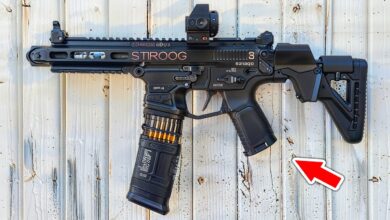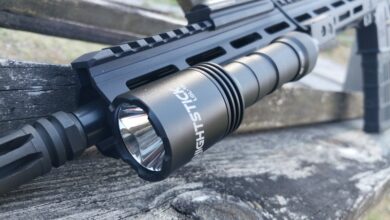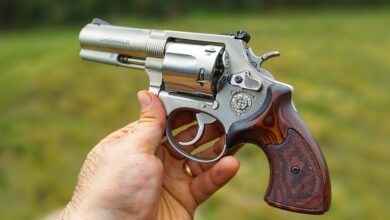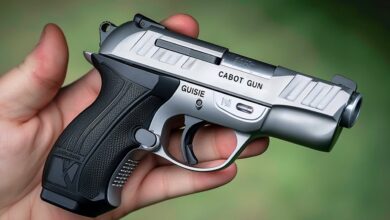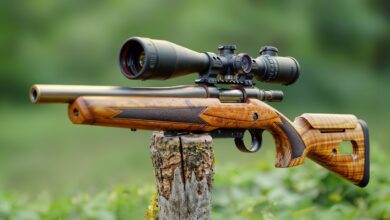Home Defense: Shotguns vs. Rifles

Today, we’ll take another look at an age-old debate: Which is better for home defense, the shotgun or the rifle? In doing so, we hope to dispel a myth or two about the capabilities of both platforms.
A major factor that could come into play is the environment in which you plan to employ your self-defense tool. The city apartment dweller will have different needs than the person living on a ranch in the Midwest with a couple hundred acres. Still, others who live in semi-rural areas have somewhat close neighbors but not right up on top of them.
Where you live is an important factor when selecting the right tool for the right job. Each tool has strengths and shortcomings. For example, the city dweller we spoke of before might not be best served with a bolt action, scoped .30-06 hunting rifle for home defense.
Could it work? Sure, but there could be major drawbacks. Among those drawbacks could be the fact that such a bullet might travel through the attacker and pose a danger to others. Or there’s the possibility that our hero might miss his target altogether, in which case a full-power .30 caliber round is now on the loose in the city. The bolt-action is also not the optimal choice for close-range defense. And a scoped rifle isn’t necessarily the greatest choice for defense in the home.
Let’s flip the scenario for a moment. Let’s say we’re living in the city, and there’s a massive riot in which people are attempting to firebomb our dwelling. That bolt action .30-06 might become a bit more relevant. Yes, I realize that’s a pretty wild scenario, but it’s one that we’ve seen unfolding in recent years, so it’s not completely outside the realm of possibility.
What Are We Defending Against?
The first and most obvious entity that most of us imagine defending ourselves against at home is intruders. If you want to get a picture of what we’re talking about, go to YouTube and type in “Home Invasions.” You can sit for hours, watching organized teams of bad guys bashing their way into normal people’s homes. Some pose as delivery personnel to get the owner to come to the door, whereby they launch their attack. Others simply launch an onslaught against an entrance point without warning to overwhelm the home’s occupants.
Whatever the style being used, we need to be able to repel such an invasion, assuming that once these attackers are in our home, they mean to do us harm. The vast majority appear to be armed with firearms. Strangers with guns in my home is a massive no-no.

Aside from humanoids, some folks have to deal with other threats. The rancher or person living in the country might need to keep on guard against bears or mountain lions. Such creatures can move with lightning speed, surprising people who aren’t prepared. During such an attack, they’re going to need a weapon powerful enough to put down their attacker.
Choices
We’ll take a peek at a few choices of weaponry with which to repel these dastardly demons. Nothing exotic, mind you, as we go by the KISS (Keep It Simple, Stupid) principle.
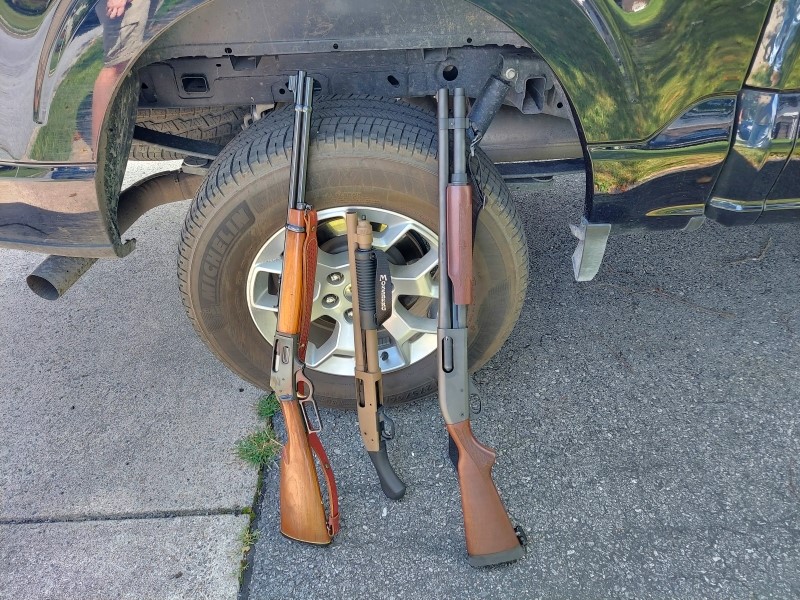
Shotguns
As far as raw power goes, the shotgun is king, unleashing multiple pellets with one pull of the trigger. All those pellets hitting the target at one time is the factor that makes it lethal.
Certainly, it’s not because of their superior ballistics since the pellets aren’t rifled, such as in a pistol or rifle. Their penetration into attackers isn’t as deep as a rifled projectile. But as we said, there’s a lot of them, and all at once.
Myths about the shotgun abound. One of the biggest myths is, “You don’t have to aim the shotgun; just point it in the general direction of the target, and you’re bound to hit it.” That is complete nonsense; you do have to aim the shotgun, especially while inside your house. A rough rule of thumb is that the shotgun’s pattern opens approximately one inch per yard to the target, although several variables come into play. The barrel length and the type of load being used are just two of them. So yeah…do aim the shotgun!
Another myth is that the shotgun won’t penetrate the walls of your home. Don’t believe that; it definitely will penetrate interior walls. I’ve seen demonstrations where a shotgun loaded with buckshot penetrated several standard walls. If you miss your target, other family members (or neighbors) in adjoining rooms will be in peril from the pellets. Even if the shotgun is loaded with birdshot (not recommended for defense), it can still penetrate walls.

Some will cite the shotgun’s low magazine capacity as a drawback. However, most pump action or semi-auto combat-type shotguns hold at least five rounds, if not more. For dealing with home intruders, the capacity of most such shotguns should suffice. As long as you hit your target, the attacker will be very likely to go down because of the trauma that the shotgun delivers, assuming you’re using the proper ammunition.
Whether you’re using 12 gauge or 20 gauge, it is likely to be effective at stopping bad guys or most four-legged attackers. 20 gauge will offer less recoil but will deliver less payload and have less range.
As for 12 gauge, the effective maximum range for buckshot will probably be around 35 or so yards. For most home scenarios, that’s enough range to get the job done, though that will depend upon the size of the homeowner’s property. For inside the home, it should be perfectly fine. My 870 will keep all the pellets in the head of a target at 15 yards when using Federal Tactical Low Recoil buckshot. These types of rounds shoot tight patterns and can extend the effective range of your shotgun by several yards.
Rifles
Everyone knows that rounds like .223 or 5.56mm will break apart as soon as it hits inside walls, right? Unfortunately, that’s another myth. Most of the rounds used in those calibers will keep traveling right through walls (and several of them, to boot), which can endanger people in other rooms. Check out some tests conducted with these bullets, it can be very enlightening.
That said, lighter calibers, such as 5.56mm, offer less danger of collateral damage than something in .30 caliber, both inside and out. The 5.56 rounds do break up and/or stop sooner than the larger calibers, but they’re still dangerous.
Some people, depending on where they live, might want that .30 caliber capability, though. Let’s say you’re fishing in an area frequented by grizzly bears. A 5.56mm will not be your optimal choice, but something in .30 caliber (or larger, even including the 12 gauge) might be a wiser choice.
Sometimes, people might want to reach out beyond the 35-yard range of the shotgun, in which case the rifle will shine brightly. The reason why I often favor a rifle is that I can put one projectile precisely where I want it. To me, that can be preferable to launching a swarm of projectiles in certain circumstances.
Semi-autos are probably your preferred home defense rifle choice here, though the lever action is also popular.

Some wise semi-auto choices include the various AR-15s and Ruger’s Mini-14. We’ve even seen Ruger’s 10/22 used in home defense scenarios. Don’t laugh at it just because it’s a .22. When loaded with the BX-25 magazine, it offers 25 rounds and has just about zero recoil and muzzle blast. No, the .22 is not optimal, but sometimes, it can get the job done.
Also, take into account the laws of your state, which might restrict weapons like the AR-15, AK-47, or other semi-autos. In those cases, sometimes the Mini-14 is legal and still offers semi-auto firepower. The lever-action platform is also seen as a “friendly” alternative, considering that most people don’t become alarmed when they see one. In the ban states, these “friendly” rifles can often fly under the radar.
Closing Thoughts
I’m a rifle guy and have been firmly in that category for many decades. That said, in addition to my rifles, I have a combat shotgun within easy reach for home defense.
Why have both? Again, the right tool for the right job. If someone’s kicking my front door in, the shotgun is excellent for close-range stopping belligerent bipedal beings, and if any pellets travel out my front door, they’ll pose a lot less risk to neighbors across the street than will rifle rounds. And that’s an all-around point to consider: while buckshot will penetrate walls, it will not go as far as most rifle rounds, so the shotgun reduces (not eliminates) the danger of collateral damage.
As you look at your property, envision ways in which you might be attacked, and then plan accordingly to decide whether a shotgun or a rifle might suit your needs best. Or maybe you’re like me and opt to have both ready and on hand.
Even if I were living in a city, my main defensive long gun would be the shotgun, but I’d still have a rifle on hand, just in case.
Once you make your choice, my best advice is to get training in defensive shooting and become intimately familiar with your weapon(s) of choice. When your abilities increase, so does your confidence.
The post Home Defense: Shotguns vs. Rifles appeared first on The Mag Life.
Read the full article here

